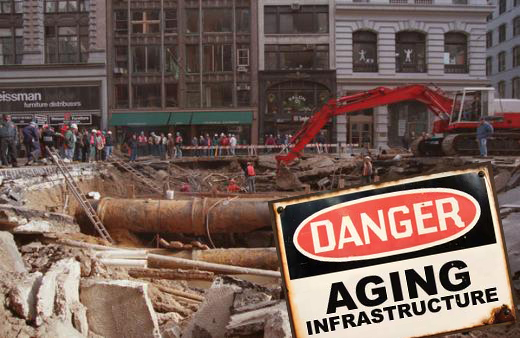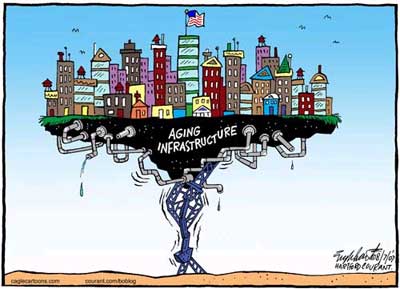Someone smart said that in the game of life, only Mother Nature is undefeated. But while we have little control over Mother Nature’s whims, we do control the network that moves one of her resources — water — to where it’s needed.
America was built on top of water and waste water pipes and tunnels. And today, that foundation is crumbling right under our feet. Last year, the American Society of Civil Engineers said U.S. water and waste water systems are close to failing. It’s now estimated we’ll need to spend $4.8 trillion over the next 20 years to fix these systems and maintain the country’s current water service levels, according to the U.S. Conference of Mayors.
Despite this, the federal government continues to ignore the problem. In fact, federal spending on water infrastructure is down more than 30 percent since fiscal year 2012.
Doctors think a person can survive without water for about three days. If our water infrastructure fails, how long could the American economy survive?
In agriculture, readily available water turns meager crop yields into booming harvests. It strengthens the root systems of feedstocks, which helps fatten livestock populations. Greater food supplies lead to fuller markets and, ideally, lower prices for consumers. They also increase supply for exports, strengthening the U.S. balance of trade.
Water, which is used to cool power plants and extract and process fuels, is also at the core of ongoing efforts to increase domestic energy production and lower our reliance on foreign energy sources: Equipment manufacturer GE reports a tripling in demand for water for energy production since 1995.
And water infrastructure investment means jobs. In San Francisco, since 2007, the $4.6 billion investment in the region’s water system rebuild has employed 11,000 workers and counting. The U.S. Department of Commerce estimates each of those jobs created locally creates 3.68 jobs in the national economy. Each public dollar spent yields $2.62 in economic output in other industries.
But for all the harm water-system failure could do to the national economy, local governments alone shoulder the burden: 98 percent of infrastructure improvements for water and sewer are paid for by local public agencies and their ratepayers.
In our two cities, the urgency of the problem is palpable.
In 2013 alone, Houston lost more than 22 billion gallons of water — 15 percent of the city’s total water supply — due to leaking pipes. That same year, there were 100 water main breaks in San Francisco.
By ED LEE and ANNISE PARKER




